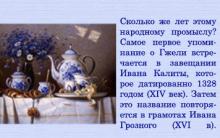From the beginning to the present day...
Nowadays, Gzhel is usually understood as a type of Russian folk art - ceramic products painted in a special style. A feature of Gzhel painting is the use of three primary colors: white, which makes up the background of the product, blue and light blue, with which the drawing itself is made. Gzhel dishes and other Gzhel products are well known not only inRussia, but throughout the world.
Few people know that the area located in the southeast of the Moscow region was originally called Gzhel. The inhabitants of the villages and villages located in this area were excellent masters of pottery. And only in the distant future, one of the most famous types of folk craft received the name of the area.
One of the reasons for the development of this particular craft was high-quality Gzhel clay. After all, as you know, an initially defined type of activity appears exactly where there is material. The development of pottery in the Gzhel area began in the 4th century BC. In the XIV century, the Gzhel land became the center of ceramic production in Russia. It was there that they made ceramic products for the Grand Duke Ivan Kalita himself.

Production expanded, new technologies appeared, it also grew andpottery skill. At the beginning of the 18th century, the production of porcelain products was mastered, and the so-called "semi-faience" was also obtained. It was his masters who painted with blue paint, which later became a symbol of Gzhel products. Initially, golden tones, fashionable at all times, prevailed in the coloring of porcelain products.

Unfortunately, at the end of the 19th and beginning of the 20th century, the industrial crisis in Russia had its impact on folk art as well. Again, the production of ceramics was established only in the middle of the last century. It was then that a new design was developed in the organized artel "Forward, ceramics" - blue painting on a white background. Products were made of porcelain, and the paint was based on high-temperature cobalt. It was on the basis of this artel that the Gzhel association was created, which actually brought together the best masters of this art. In the late 80s, the leading artists of the factory were awarded the Repin State Prize "For achievements in the revival, formation and development of the art of Gzhel, in the creation of a modern style of Gzhel porcelain with cobalt underglaze painting."
Gzhel is a product made of high quality ceramics or porcelain, painted in a special way: with blue paint on an impeccably white background. it original Russian folk craft, named after the village of the same name.
The village got its name from the word "zhgel", which meant "burn" or "burn" - a familiar term from the lexicon of potters.
Blue on white.
Story
In the middle of the 17th century on the banks of the river Gzhelka in the ancient village of Gzhel, located 60 km from Moscow, ancient masters of pottery lived and worked. They mined clay, which was very rich in their area, and made from it: bricks, tiles, tiles, pottery pipes, children's toys and dishes.
It is a historical fact that the surprisingly high quality clay from the Gzhel deposit was appreciated by the Russian Tsar Alexei Mikhailovich. He issued a decree ordering the use of clay from this deposit for the manufacture of apothecary and alchemical utensils.
Pottery developed rapidly. Over time, the so-called "Gzhel Bush" already included 27 villages. By 1812, 25 factories and many private handicraft industries were producing dishes.

In the 18th century, the Gzhel workshops made porcelain using the Majolica technique - at that time it was popular.
By the end of the 18th century, 50 factories were already operating in Gzhel. Products from amazing clay were served throughout Russia, and even in the countries of Central Asia.
However, with the onset of the industrial crisis during the development of capitalism, folk craft began to fade. And by the end of the 19th century, it had almost completely disappeared.
Features of Gzhel painting
Gzhel painting is easy to recognize among other areas. Her characteristic style is blue and blue patterns on a dazzling white background.
For drawing a picture cobalt is used as a paint. It acquires a characteristic blue color during the firing process.
The images use geometric belts, floral patterns and floral ornaments. On large items, you can find whole landscapes and architectural structures, as well as conditional images of figures of people and animals.

Hedgehog, cow and horse.
Drawing on ceramic products applied by hand with a brush. This allows you to create images with cobalt oxide with many shades: from deep dark blue to delicate blue.
Gzhel at present
Today in Russia, Gzhel painting is very popular. On the site of a small old factory Today the Gzhel Porcelain Factory is operating.

Gzhel Porcelain Factory.
The company employs hundreds of craftsmen who have preserved the experience and traditions of their ancestors.
The factory produces, hand-painted with cobalt painting:
- tableware;
- vases;
- candlesticks;
- figurines;
- lamps;
- watch;
- caskets;
- fireplaces;
- chandeliers;
- teapots, etc.
The plant's product range reaches 600 items.

Not only dishes and animals, but everything, everything, everything ...
High-class professionals - technologists and artists skillfully combine technological innovations and centuries-old traditions of art in the production of products.

Porcelain shop in the village of Gzhel.
How to distinguish a genuine product from a fake
Gzhel is an exceptionally high-quality product. They are highly valued both in Russia and abroad. But sometimes you can find fakes. As a rule, they do not differ in workmanship, and the pattern is applied to them with ordinary paint, instead of cobalt oxide.
Real Gzhel can be distinguished by the following features:
- the surface of ceramics or porcelain is perfectly smooth, and the background is snow-white;
- on the bottom of the product there must be a Gzhel corporate stamp - a swan, or the word "Gzhel" is written and circled in an oval in clear large letters;

Company brand.
- on especially valuable products, there may be a mark “painted by hand”, and even the name of the master;
- real Gzhel is surprisingly durable, as it is made from unique varieties of white clay with the addition of quartz sand;
- the drawing made by the master is distinguished by the quality of drawing details;
- the form of products is simple, without excessive pretentiousness.
With frost on white. The inhabitants of the village of Gzhel say: their sky, like nowhere else, is blue-blue, so they decided to transfer the heavenly colors to white porcelain. Interesting facts about the development of the ancient craft were collected by Natalia Letnikova.

Gzhel is not only a village and craft, but a whole pottery region.
27 villages, the so-called "Gzhel Bush". The first mention is in the time of Ivan Kalita.
They made ceramics, and when the peasants, the Kulikov brothers, unearthed white clay, they switched to porcelain.

Gzhel clay is a strategic resource.
In the 17th century, by order of Alexei Mikhailovich, it was used for pharmaceutical and alchemical vessels.
During the time of Petrova, she went to brick, under the Empress Elizabeth - for the first porcelain factory in Russia.
Illustration: Portrait of Empress Elizabeth Petrovna. A.P. Antropov. Late 50s - early 60s of the XVIII century

The secret of making porcelain has been fought over since the time of Peter I.
Sending spies did not bring success - the scientists managed.
Lomonosov's friend, chemist Dmitry Vinogradov, described the technology for the production of Chinese porcelain.
Illustration: Dmitry Ivanovich Vinogradov. Miniature by an unknown artist

All the secrets of painting are in the ABC of Strokes.
Alexander Saltykov collected the experience of generations under one cover.
In the middle of the last century, the count, a ceramist and art critic, revived the craft almost from scratch.
It is based on the collection of the State Historical Museum.
Illustration: Gzhel ornaments

Even during the times of serfdom, Gzhel artists were considered free.
Since the 16th century, they were assigned to the Palace and Specific departments and were engaged only in ceramic craft.
Illustration: work on a potter's wheel

Initially, Gzhel was multi-colored.
The fashion for cobalt came from Europe and Asia in the 19th century. Dutch white and blue tiles and Chinese porcelain set the tone.
I “tried on” Gzhel cobalt - and so it remained white and blue.
Illustration: colorful gzhel

The Gzhel pattern is applied with black cobalt, and after firing it receives its own blue.
Gzhel masters distinguish 20 shades of blue.
Will the color be lighter or darker, it all depends on the master. How he puts a brush stroke.
Illustration: Gzhel porcelain painting

The favorite pattern of Gzhel masters is a rose. Nicknamed Agashka in the craft environment.
At the porcelain factories of the 19th century, there were many Agafias among the peasant women artists. That's where the name stuck.
Illustration: Gzhel teapot with a traditional pattern

Agitfarfor is the main theme of Gzhel painting during the Civil War.
Invented by the French of the era of the bourgeois revolution. In the Soviet years, the ideas of communism in ceramics were exported.
Today, the price of an ideological heritage at a London auction is up to four thousand pounds.
Illustration: porcelain figurine of the USSR era

The main secret of Gzhel has not been revealed so far - where did the name of the craft come from.
There are several versions: from the old Russian "zhgel" - the dishes are fired in the oven. In honor of the river Gzhelka in the Smolensk region.
Or from "gzhiolka", as the wagtail used to be called. Guessing is not the first century.
Illustration: Gzhel tableware with a traditional pattern.
For hundreds of years, Russian masters have demonstrated their talent in various trades and crafts, because what is only worth the artistic painting of dishes, trays and other kitchen utensils, presented in various techniques. For this reason, in high school, reports are often prepared that reveal the features and types of certain skills, a good example of which can be a message about Gzhel.
Basic concepts and history of occurrence
Gzhel painting is known not only to the inhabitants of Russia and the entire post-Soviet space, but also far beyond its borders. Delicate patterns of pale blue and rich blue, applied to fine snow-white porcelain or ceramics, have become popular all over the world, because dishes and other products decorated using this technique fit perfectly into almost any interior. Such pleasure costs a lot of money, like many other folk crafts, which are based on manual work.
The name of the technique has Baltic roots, but it takes its origins from the Russian village of the same name, located in the near Moscow region. Some researchers believe that the name of the mural may come from the Prussian word, literally translated as "shrub". As for the history of the emergence of the Gzhel fishery, the following facts are known today:


Fortunately, it was possible to revive it, albeit not on its former scale. Restoration began in the middle of the last century, and most recently the legendary craft celebrated its 670th anniversary.
Types and features of Gzhel
Gzhel today is not just dishes, stove lining or decor, but a real luxury that few can afford. Nevertheless, the demand for such products does not fall, and today private art workshops are even opening, deeply studying this area without pretensions to originality. You can go to training courses and master classes in order to get acquainted with the main ornaments used in the craft, and practice painting plates, gradually mastering the technique.

Key areas
Having become acquainted with where the ancient craftsmanship appeared, it is worth delving into the study of its features. Now three main types of Gzhel are known, which replaced each other depending on the raw materials used and other circumstances. This list includes:

All of the listed samples of Gzhel painting differed not only in the application technique and patterns, but also in the material used, as well as in the composition of the base used for artistic painting. The first two types of fishing were relevant in the period from the 18th to the 19th century, although outwardly they practically did not resemble each other.
For the production of majolica, snow-white clay was used, the finished products from which were painted in yellow, green, blue and graphite. The technique was completely different, as well as the key elements of the Gzhel semi-faience painting, where for the most part the naive style was involved with its inherent ornaments, berries, foliage, birds, houses and plot pictures.
Raw materials were used for the manufacture of three main groups of goods: cheap dishes, expensive vessels, often used to decorate the house, as well as small figurines, souvenirs and toys. Staining according to the majolica technology was carried out on liquid enamel with a phased drawing of the dark contour of the main elements and their further color filling. Roasting ensured the strength of not only dishes, but also their coatings, so the craftsmen had to act with extreme precision due to the impossibility of correcting mistakes.

Gradually, the form of manufactured products also changed. It became more pretentious under the influence of the baroque fashion, and then returned to the original primitivism, as the quality of the main raw materials was lame. For example, products made of semi-faience, which were based on gray clay, were distinguished by the simplicity of forms, the simplest elements of painting and paler colors (as a rule, only blue was used). This was explained by the fragility of the material, as well as its excessive porosity and roughness, when compared with white clays.
Gzhel porcelain, produced before the 40s of the last century, also bore little resemblance to later samples, including those that can be found now. For its manufacture, thin artsy stucco and the most complex elements of painting were used, which were based on yellow, red, green, blue, brown, pink and even gold.
After 40s. expensive imperial porcelain with hand molding, firing and painting gave way to the so-called stamped product, although its release was soon limited due to the crisis that gripped Russia. They tried to compensate for the low quality of raw materials with polychrome type paint. After the war, even a proposal was put forward to revive majolica, which was rejected due to the complexity of the technology. As a result, it was decided to make thick-walled dishes covered with a single-color blue painting.
Colors and motifs
After the 40s, workshops began to open, designed to teach new specialists the art of drawing using the Gzhel technique. The famous artists Natalya Bessarabova and Alexander Saltykov became the authors of the patterns. It was they who stood at the origins of the revival of the craft, having developed a methodological manual that reveals the secrets of working with a thin and wide brush on porcelain . Drawing in the Gzhel technique is divided into three main types:

The technique is based exclusively on manual work using all cobalt shades (more than 20 different types), as well as white and other colors, which is important for majolica (yellow, green, blue and cherry patterns on a white background). If we talk about tools, then the set necessary for painting is striking in its simplicity, consisting of glasses for mixing and diluting paints, brushes with natural bristles of different thicknesses, spatulas, and a jar in which cobalt oxide is prepared.
To apply an original ornament, there is a whole alphabet, which is based on a droplet stroke, most often used to display leaves, berries and flower petals, and a reverse stroke, which implies a transition from a darker and more saturated tone to the lightest possible . The most recognizable patterns of Gzhel technology are:
- a rose made with large strokes;
- a bird with wide spread wings.
The choice of pattern directly depends on the shape, since it should ideally “sit down” on the base. It is he who revives it, making cold porcelain voluminous and alive.
Drafting a technical report
Gzhel painting is a very interesting topic that will surely be remembered by connoisseurs of folk art and lovers of home comfort, since the vast majority of products are intended for use in everyday life and interior decoration. But if a child has to write a fishery report, then it is necessary to adapt the story to the school audience, supplementing it with visual drawings, photographs, or even original samples. The text is best composed in accordance with the following plan:

Gzhel is a traditional painting on ceramics, which has become famous due to its rich cobalt hues, bright majolica and amazing harmony of patterns and ornaments.
The painting got its name thanks to the picturesque area near Moscow, also known as the Gzhel Bush. For more than 700 years, Gzhel masters have been creating real works of art - dishes, figurines, interior items, painted with bright ornaments depicting flowers, animals or landscapes. All work is done only by hand, which gives it value. Machine Gzhel painting does not exist, each product is original, displaying a particle of the soul invested by the author.
The history of the fishery

The first official mention of the region was found in Kalita's spiritual charter dated 1328, but it is proved that Gzhel settlements existed and were actively engaged in various crafts as early as the 11th century, although pottery was not included in the official list of duties before the sovereign's court. The region became the main supplier of Gzhel clay and finished products for “pharmaceutical needs” only in the 17th century under Tsar Alexei.

The main difference between Gzhel painting is its originality and individual style. At the beginning, these were stucco toys and household items with beautiful and bright majolica, but gradually the art and craftsmanship developed and became more perfect. There were decorative dishes and sets of dishes, high kumgans with a disc-shaped body. Small plastic art in the form of kitchen utensils and toys has also become widespread, captivating with its uncomplicated drawings and pictures, landscapes, and floral ornaments.

Since the 19th century, the production of semi-faience has been launched on the territory of Gzhel, which has become a transitional period from traditional majolica to fine faience and porcelain. The characteristic underglaze painting of rich blue hues, monochrome drawings, polychrome overglaze drawing, an abundance of gold and a unique cobalt background covering were used as decoration. Particularly famous were products manufactured at the factories of the Terekhovs, Barmins, as well as the Kuznetsov Brothers, Kiselevs, Zhadins, Tulins.
Gzhel painting colors

A feature of Gzhel painting is exclusively handmade, in each ornament the artists put a particle of themselves and their vision of nature and surroundings. The main colors are:
- white, used for bone china;
- colored majolica;
- shades of cobalt and bright blue, ranging from sky blue to rich, dark blue;
- dull cobalt.
The process of manifestation of a characteristic saturated color is very interesting - during operation it is black and white, and blue and cobalt shades appear only when the finished product is fired at high temperatures.
Primary colors

The traditional color for Gzhel painting is a bright blue, cobalt shade on a snow-white background. Painting is carried out using a special composition based on cobalt oxide. The finished product is dipped in white glaze, then fired at 1400 degrees. As a result, the glaze becomes transparent, and the ornament acquires a bright blue color, the product itself becomes solid and has a glossy sheen. A thin gold or platinum decoration can be applied over the fired glaze, after which the product is fired again.
The following groups of colors of the Gzhel painting are distinguished:
- Overglaze color painting, complemented by gold and platinum decor, cobalt color. It is used for elegant sets of dishes, souvenirs, jugs or teapots. For work, bright colors are used, overglaze painting, also known as majolica. The process is laborious and complex, requiring real skill from the artist.
- Deaf background cobalt captivates with an unusual combination of sophistication and solemn luxury. The background base is a dark blue glaze, overglaze white paint is used for painting, creating a mirror image of traditional Gzhel. Flowers and animals turn from blue to white, and the ornament itself resembles fabulous frosty patterns that create an effect of depth.
- Bone white porcelain is snow-white products without decor or with fine platinum or gold painting. It is allowed to apply small-sized drawings and inscriptions using colored paints or all shades of blue.
Elements and patterns of Gzhel painting
The theme of the painting reflects the master's perception of the world around him, this is the result of the development of centuries-old folk art, absorbing traditions and culture. Artists in their creations combine elements of icon painting, everyday scenes, observations of nature. Most often there are natural motifs, architecture: plants, birds or animals, images of peasant houses, churches or city streets.

The modern theme of the drawing is divided into 4 types:
- plot drawing, including seasons, landscapes;
- ornamental - traditional for Gzhel mesh-combs, antennae, pearls, droplets, checkers and layering;
- plant drawings - cereals, berries, flowers, buds, grass, branches;
- animals (most often these are birds).
Execution technique

The main rule of the Gzhel painting technique is only manual execution of the drawing. The painters use white, blue and blue colors in their work. Blue color is used in more than 20 shades, five-flower is used for majolica - white background, yellow (antimony salts), green (copper salts), blue (cobalt salts), cherry (manganese moths) colors.
The artist's set of tools is very simple: a glass palette for mixing shades, brushes of various types, spatulas, cobalt oxide mixture jars. The classic cobalt pattern is applied using the underglaze technique, that is, after application, the ornament is covered with white glaze and fired. To apply ornaments, a special alphabet of strokes is used, which each master can have its own characteristics. At the heart of most patterns is a droplet brushstroke, which depicts leaves, stems, flowers. A smear with shadows is a reverse stroke in one direction with a transition from a dark shade to a light one.

The most popular patterns are the Gzhel rose with sweeping, large strokes and a bird.
Gzhel with traditional blue painting is a single whole of form and product and decor. The drawing emphasizes the shape, gives volume and harmony, enlivens cold porcelain. But it is plasticity that dictates what the ornament and its shade will be, what exactly will be expressed by the artist in the finished product.











Scenario New Year's holiday "meet the year of the monkey"
Situational Marketing What reasons for situational content can be used in November
Effective ad formats in Yandex
Getting money at the airport
How is the Tax Free refund amount calculated?